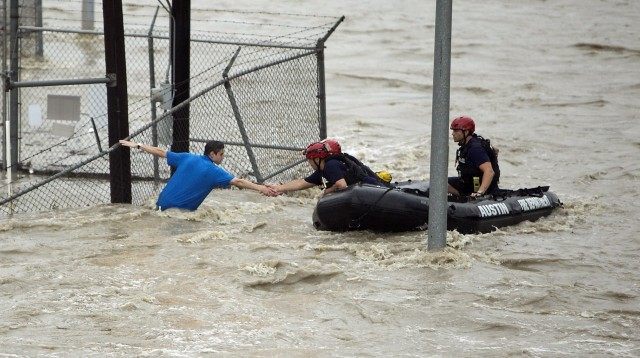With devastating floods ravaging counties across Texas, the establishment Left isn’t waiting for rescue workers to finish cleaning up the mess before they declare the culprit: climate change deniers.
The eco-doomsayer Think Progress will explain it to you:
Texas and Oklahoma both face intensifying drought and flooding, although politicians in both states have denied climate change. According to the Natural Resources Defense Council, Texas “has yet to formally address climate change preparedness” — one of only 12 states to not have taken any steps toward addressing the impacts of climate change on water resources.
“Between more intense rainstorms and sea level rise, flooding will only increase if we don’t address climate change,” according to the Natural Resources Defense Council.
Of course, the usual suspects have chimed in on social media:
New York University sociologist Eric Klinenberg gets a double liberal score by managing to pack in both climate change AND infrastructure:
Let’s look at some Texas history to see if 2015’s extreme weather is a sure sign climate change deniers are leading us to towards a disaster movie ending.
Back in 2007 before President Obama wanted to warn us about global warming, there was another big flood in Texas, which caused 11 deaths. An incredible 18 inches of rain fell in just a few hours in Marble Falls, Texas.
As Fox News reported in 2007:
When we rolled in to Marble Falls, the first thing we noticed was buckled pavement. Huge chunks looked like big jigsaw pieces ripped from the road. We stopped at a cement business that had been flooded. Water rolled up sections of the metal like you might pop the top of a tuna can. A woman standing by was clutching her baby boy. She worried the cement shop might not open again and leave the boy’s father out of work. About 150 businesses and homes were damaged or destroyed here. Governor Rick Perry says the damage alone could reach more than $100 million.
Sure, but maybe global warming was already well underway in 2007. Let’s skip the Texas droughts in the 1970s and look at the 1981 flooding.
A news conference Tuesday in Austin tells us that more water fell during the 1981 flooding that also happened on a Memorial Day weekend.
Watershed Protection supervising engineer Kevin Shunk said during a press conference Tuesday afternoon that about 3 inches of rain fell during a three- to four-hour period Monday. During the Memorial Day storm of 1981, about 10 inches of rain fell in three hours, Shunk said.
He added that while the city did not see as much rain on Memorial Day this year as it did in 1981, the ground was already saturated, so more of that rain became runoff
Back to the droughts. You’ll remember that Think Progress lectured us about extreme changes being a gauge of climate change. According the Texas State Historical Society, is seems that the 1950s were a harbinger of the climate crisis, along with…well, every other decade.
There has been at least one serious drought in some part of the state every decade of the twentieth century. The most catastrophic one affected every part of the state in the first two thirds of the 1950s. It began in the late spring of 1949 in the lower valley, affected the western portions of the state by fall, and covered nearly all Texas by the summer of 1951. By the end of 1952 the water shortage was critical; Lake Dallas for instance held only 11 percent of its capacity. Spring rains in 1953 gave some brief respite to Northeast Texas. In the Trans-Pecos, however, only eight inches of rain fell the entire year of 1953, and the drought grew worse from 1954 to 1956. Streams only trickled or dried up completely. The drought ended abruptly in the spring of 1956 throughout Texas with slow soaking rains
Prior to the 1950s, the extreme weather still existed as we learn from looking at the Great Texas Floods of 1935.
An article on TexasEscapes.com has details and photos on the floods that ravaged the state. Of course, applying the same ‘correlation equals causation’ fallacy, one might be tempted to blame that flooding on FDR and The New Deal… but let’s just look at facts.
First, about that infrastructure that the sociologist from New York focused on: apparently infrastructure actually improves over time, even in a mixed economy. As the same article points out:
The 2007 flooding around Burnet, Marble Falls and Cedar Park brought nearly 20 inches of rain in a 24-hour period which is far more than the 9.21 inches of rain Austin received for the month of May 1935 or the 9.71 inches that June. But when one factors in ground saturation and no run-off channels, the resulting damage of the 1935 rains was far worse.
Okay, but the weather in 2015 must be a lot more extreme because… Republicans or something. Not according to history.
In 1935, while Austin was receiving its deluge, San Antonio was hit even harder with 14.07 inches in May with 8.41 inches the next month. The stores around Alamo Plaza were flooded in late May and tiny D’Hanis, Texas reported a hard-to-believe 20-24 inches of rain in just 2 Hours and 45 Minutes.
Early to mid-June rains approached 20 inches in many other smaller communities from Uvalde to Austin. The Llano, Colorado and Pedernales Rivers all reached flood stage, affecting the cities of Junction, Llano, and Fredericksburg. On June 14 and 15 the Colorado River was just 1 foot below the record reached in July of 1869.
Oh, no. The record was in 1869?
Now we know the problem: Ulysses S. Grant.

COMMENTS
Please let us know if you're having issues with commenting.